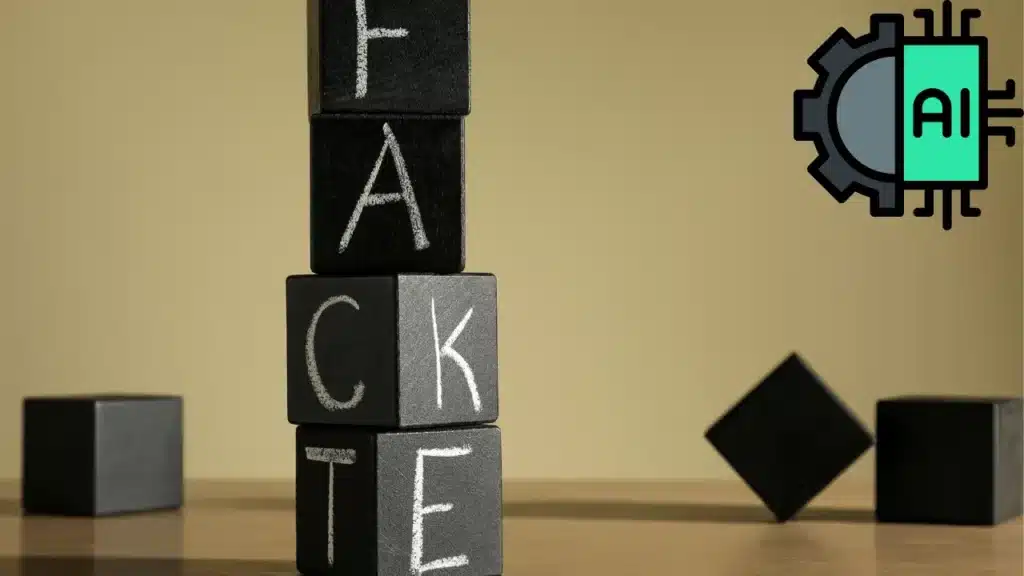How does Generative AI helps misinformation on social media?
Can we truly believe the news we see on social media, where millions of people rely?
A digital environment brimming with deepfakes, fake news, and false narratives has been fueled by the proliferation of AI-generated content. The rate at which generative AI produces false but convincing content is startling.
Propaganda can be disseminated and public opinion manipulated by driven by AI chatbots, deepfake videos, and automated posts. False news spreads six times faster than true news, according to an MIT study, raising serious concerns about AI’s role in disinformation.
However, can AI contribute to the fix or is it solely to blame?
AI, according to experts including misinformation researcher Dr. Kate Starbird, can assist in identifying and thwarting false information. We’ll examine how, in the digital age, AI both promotes and counters disinformation.
To avoid AI detection, use Undetectable AI. It can do it in a single click.
Table of Contents
What are Generative AI, AI, and Machine Learning?

A group of concepts, resources, and techniques related to a computer system’s ability to carry out tasks that are typical for human intelligence are commonly referred to as artificial intelligence. When discussing artificial intelligence in the context of journalism, we often refer to machine learning, which is a subfield of AI.
The process of teaching a piece of software, referred to as a model, to produce content from data is referred to as machine learning. Statistics, which is referred to as the art of knowledge extraction from data, is where machine learning has its roots. Machine learning uses data to provide answers to questions.
Simply speaking, it refers to the application of algorithms that analyze data to identify patterns and carry out operations without explicit programming. In other words, they acquire knowledge.
A machine learning model that attempts to predict and produce plausible language — that is, language that is natural or humanoid — is identified as a language model. It is simply a probability model that predicts the next word in a sentence based on previous words using an algorithm and data set.
These models generate new and unique data and content, which is why they are referred to as generative models or generative AI. While traditional AI does not produce original content, it does concentrate on executing predefined tasks using predefined algorithms.
Read Also >>> How Do I Make an AI Generated Image More Realistic: Create Realistic AI Images in 2025
Models become complex and effective when they are trained on vast volumes of data. Modern large language models can forecast the probability of sentences, paragraphs, or even entire documents based on historical patterns, while early language models could only predict the probability of a single word.
The release of Transformers, a deep learning architecture based on the concept of attention mechanisms, in 2017 marked a significant advancement in language modeling.
This innovation increases a model’s capacity to capture pertinent data by enabling it to selectively focus on the significant portion of the input to formulate the prediction.
Google Streetview’s house number identification is used by the computer science portal Geeks for Geeks as an illustration of an attention mechanism in computer vision, which enables models to consistently recognize specific areas of an image for processing.
By resolving memory problems in previous models, attention mechanisms also enabled processing longer sequences. The advanced architecture for a broad range of language model applications, including chatbots and translators, is transformers.
The popular chatbot, ChatGPT, is built on an OpenAI language model. It is renowned for its ability to process natural language and is based on the GPT model architecture.
What is the Impact of Generative AI on Misinformation?

Generative AI is the latest technology to enter a previously human-only field: autonomously producing any kind of content, in addition to comprehending and producing language and meaning.
The fact that it is frequently impossible to determine whether content is created by a human or a machine these days, in addition to whether we can trust what we read, see, or hear, is exactly what connects generative AI to the discussion of disinformation.
People who use media have begun to realize that something is wrong with their relationship with it and are perplexed.
Some of the indicators that we used in the past to decide we should trust a piece of information have become distorted, said Vinton G. Cerf, sometimes referred to as the fathers of the internet, in a 2024 video podcast hosted by Freshfields Bruckhaus Deringer, an international law firm.
Because they do not adhere to many of the conventional rules of journalism, such as depending on reliable sources, generative resources are distinct. It is time to abandon the notion that every text or visual piece of content has an author or creator. There is no longer a connection.
How Does Generative AI Helps Misinformation on Social Media?

From completely AI-generated fake news websites to phony Joe Biden robocalls advising Democrats not to cast their ballots, GAI is producing a wide variety of misinformation.
Researchers are rushing to identify and analyze the effects of the rapidly evolving technology, while media systems are struggling to adjust, learn how to use it safely, and avoid hazards.
From the perspective of the user, generative AI is responsible for a general decline in media trust and it is becoming difficult to confirm the veracity of content, particularly in the run-up to elections.
Using a person’s identity to produce non-consensual explicit content is possible with deepfakes, which can cause serious privacy violations and harm to people, particularly women and marginalized communities.
Amplification, Automation, & Volume
With GAI, the amount of misinformation might increase indefinitely, causing fact-checking an inadequate technique. Due to social media, the costs of disseminating misinformation are almost zero, just as the marginal costs of producing it are approaching zero.
Furthermore, formerly requiring entire teams of tech-savvy people to create, people can now quickly and easily create complex and convincing GAI content, such as voice clones and deepfake videos, using user-friendly apps.
The barrier to entry for producing and sharing misleading content and false narratives online is lowered by this democratization of deepfake technology. Regardless of the language, malicious actors can quickly and easily use chatbots to propagate false information online.
In order to disseminate false information, large volumes of text in addition to highly realistic fake audio, images, and videos can be produced using text-to-text chatbots such as ChatGPT or Gemini or image generators such as Midjourney, DALL-E, or Stable Diffusion.
False narratives, misinformation unique to a considering country, swaying public opinion, and even injury to people or organizations may arise from this.
Researchers at the University of Zurich in Switzerland discovered in a 2023 study that while generative AI can generate readable and accurate information, it can also generate persuasive misinformation. Furthermore, participants were unable to discern between posts created by GPT-3 and actual people on X, formerly Twitter.
The entire content creation, distribution, and amplification process can be automated by combining GAI applications. Websites can be programmed effortlessly, and completely synthetic visual content can be created from a text prompt.
Disinformation and Structural Shifts in the Public Sphere
The public sphere has been changing due to digitization for a while now. Another factor driving this change is generative AI, but it should not be seen in a vacuum. Digital media, financial strains on traditional media companies, and the reorganization of information flows and attention allocation are the primary causes of structural changes.
Another element contributing to the transformation of the public sphere is the rise in the amount of AI-generated content and the challenge of identifying it. In addition to deliberately produced misinformation, there are other causes of information pollution.
In her testimony before the US House Committee on Science, Space, and Technology, Emily M. Bender, a professor of linguistics at the University of Washington, discussed this issue.
The Advantages of Authoritarian Regimes
According to research by Democracy Reporting International, provided with fictitious prompts, ChatGPT replicates damaging narratives spread by authoritarian regimes. Researchers were able to use ChatGPT to mimic a reporter from the state-run news outlet Russia Today in one case study.
By doing this, they were able to circumvent ChatGPT’s security measures and produce unfavorable outcomes, such as endorsing the necessity to de-nazify Ukraine, a popular defense used by Russia to justify its 2022 invasion of Ukraine.
The study demonstrated how easily malevolent actors can co-opt AI chatbots to produce false or misleading information, regardless of the language used. Therefore, generative AI models created in authoritarian countries — possibly with state intervention — have ramifications that proceed beyond these borders.
The technologically sophisticated authoritarian regimes in the world have reacted to advancements in AI chatbot technology by trying to be certain the programs adhere to or bolster their censorship protocols.
According to Democracy Reporting International, legal frameworks in at least twenty-one countries require or provide incentives for digital platforms to use machine learning to filter out offensive political, social, and religious content.
GAI Might Have a Detrimental Effect on Elections
There is a unique relationship between generative AI and elections. This is due to the fact that those who participate in elections always have a specific objective in mind: either to influence the political climate of a foreign nation or to acquire authority for themselves or their allies.
GAI provides these actors the ability to fabricate unreality, and it is increasingly being used as a weapon in influence and information warfare. Political or foreign actors are primarily responsible for the coordination, concerting, evaluation, measurement, and funding of such campaigns.
The International Center for Journalists found that, irrespective of the country they investigated, election disinformation followed similar and cyclical patterns. Various countries, for instance, spread false information about the documents required to cast a ballot or the myth that votes were cast in the names of deceased individuals.
Generative AI is a best resource for developing these kinds of campaigns.
An apparent robocall that imitated US President Joe Biden’s voice using artificial intelligence to dissuade voters from casting ballots during the state’s primary election was the subject of an investigation by the US state of New Hampshire’s attorney general in January 2024.
Businesses such as OpenAI are proceeding quickly to create protections against GIA being used in a way that could compromise the electoral process.
FAQs: How Does Generative AI Helps Misinformation on Social Media?
What is Generative AI and how does it relate to misinformation on social media?
Generative AI refers to a class of artificial intelligence that can create content, including text, images, and videos, based on the input it receives. This technology, often implemented through large language models such as ChatGPT from OpenAI, has the potential to produce AI-generated content that appears authentic.
However, this capability can be exploited to spread misinformation, including fake news and false information, particularly on platforms such as social media, where content can become viral quickly.
How do AI resources contribute to the spread of disinformation?
AI resources can produce and disseminate AI-generated content at an unprecedented scale. For instance, chatbots driven by generative artificial intelligence can engage users in conversations, creating and sharing fake content that mimics legitimate news sources.
This can lead to the rapid spread of disinformation, as users may probably trust information that seems personalized or conversational.
What role do deepfakes play in the context of misinformation?
Deepfakes are a form of AI-generated content that uses generative adversarial networks to create realistic fake videos or audio recordings. These can be particularly damaging as they can misrepresent individuals, potentially leading to the sharing of false information that can harm reputations or influence public opinion.
How can machine learning algorithms identify misinformation?
Machine learning algorithms can analyze patterns in data to identify potential misinformation. By training on vast amounts of data, these algorithms can learn to recognize characteristics typical of fake news, such as sensational language or biased reporting.
However, as generative AI becomes sophisticated, distinguishing between real and AI-generated content may become increasingly difficult.
Conclusion: How Does Generative AI Helps Misinformation on Social Media?
The digital landscape has been completely changed by generative AI, which presents both opportunities and difficulties in the fight against false information on social media. Driven by AI technologies have the potential to produce false information on a large scale, but they can also be used to identify and stop the spread of misinformation.
Increased user media literacy, ethical standards, and responsible AI use are necessary. The future of online discourse can be significantly shaped by the harmony between content authenticity and technological advancements as social media platforms continue to develop.
In your opinion, how should social media companies control content produced by AI to reduce false information?


